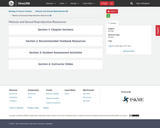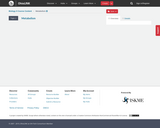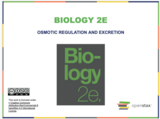
- Subject:
- Biology
- Life Science
- Material Type:
- Unit of Study
- Provider:
- Ohio Open Ed Collaborative


The theory of evolution is the unifying theory of biology, meaning it is the framework within which biologists ask questions about the living world. Its power is that it provides direction for predictions about living things that are borne out in ongoing experiments. The Ukrainian-born American geneticist Theodosius Dobzhansky famously wrote that “nothing makes sense in biology except in the light of evolution.” He meant that the tenet that all life has evolved and diversified from a common ancestor is the foundation from which we approach all questions in biology.


Animal evolution began in the ocean over 600 million years ago with tiny creatures that probably do not resemble any living organism today. Since then, animals have evolved into a highly diverse kingdom. But what is an animal? While we can easily identify dogs, birds, fish, spiders, and worms as animals, other organisms, such as corals and sponges, are not as easy to classify. Animals vary in complexity—from sea sponges to crickets to chimpanzees—and scientists are faced with the difficult task of classifying them within a unified system. They must identify traits that are common to all animals as well as traits that can be used to distinguish among related groups of animals. The animal classification system characterizes animals based on their anatomy, morphology, evolutionary history, features of embryological development, and genetic makeup. This classification scheme is constantly developing as new information about species arises. Understanding and classifying the great variety of living species help us better understand how to conserve the diversity of life on earth.



Meiosis is the process of cell division that produces haploid gametes. In sexual reproduction haploid gametes combine through fertilization to form a genetically recombined diploid zygote. Meiosis includes two successive divisions and processes such as crossing over and independent assortment that increase genetic variability in gametes produced. Life cycles detail the events between meiosis and fertilization that vary for different multicellular organisms.


The cellular processes of life require energy. How do living organism obtain energy and how is it used? This Chapter answers these questions by exploring forms of energy and energy transfer within and between living organisms, as well as the role of enzymes and adenosine triphosphate (ATP) in chemical reactions in cells.


Solute concentrations across semi-permeable membranes influence the movement of water and solutes across the membrane. Osmoregulation and osmotic balance are important bodily functions, resulting in water and salt balance. Osmolarity is measured in units of milliequivalents or milliosmoles, both of which take into consideration the number of solute particles and the charge on them. Some organisms are osmoconformers in that they are isotonic with their environment. The kidneys are the main osmoregulatory organs in mammalian systems; they function to filter blood and maintain the osmolarity of body fluids. Many systems have evolved for excreting wastes that are simpler than the kidney and urinary systems of vertebrate animals. The simplest system is that of contractile vacuoles present in microorganisms. Flame cells and nephridia in worms perform excretory functions and maintain osmotic balance. Some insects have evolved Malpighian tubules to excrete wastes and maintain osmotic balance.


Virtually all life on Earth depends on Photosynthesis. Photosynthesis uses energy in sunlight to form organic molecules such as glucose. This transformation of light energy to chemical energy provides fuel for the metabolic processes in all organisms. Photosynthesis also produces oxygen required for aerobic cellular respiration. This chapter covers light energy as part of the electromagnetic spectrum, basic structures involved in photosynthesis and the metabolic pathways of photosynthesis divided into the light-dependent reactions and the Calvin cycle.


In scientific terms, phylogeny is the evolutionary history and relationship of an organism or group of organisms. A phylogeny describes the organism's relationships, such as from which organisms it may have evolved, or to which species it is most closely related. Scientists must collect accurate information that allows them to make evolutionary connections among organisms. It is a highly dynamic field of biology because phylogenetic modeling concepts are constantly changing as new information is collected. Over the last several decades, new research has challenged scientists’ ideas about how organisms are related.


Plants are as essential to human existence as land, water, and air. Without plants, our day-to-day lives would be impossible because without oxygen from photosynthesis, aerobic life cannot be sustained. From providing food and shelter to serving as a source of medicines, oils, perfumes, and industrial products, plants provide humans with numerous valuable resources. When you think of plants, most of the organisms that come to mind are vascular plants. These plants have tissues that conduct food and water, and they have seeds. Seed plants are divided into gymnosperms and angiosperms. Gymnosperms include the needle-leaved conifers susch spruce, fir, and pine. Their seeds are not enclosed by a fleshy fruit. Angiosperms, also called flowering plants, constitute the majority of seed plants. They include broadleaved trees (such as maple), vegetables (such as potatoes), grasses, and plants known for the beauty of their flowers (roses and daffodils, for example). In this module we will be exploring the different structures found within plants, the different physiological processes performed by plants, the different mechanisms of transport that occur within plants, and various response mechanisms used by plants.


Plants have evolved different reproductive strategies for the continuation of their species. Some plants reproduce sexually, and others asexually, in contrast to animal species, which rely almost exclusively on sexual reproduction. Plant sexual reproduction usually depends on pollinating agents, while asexual reproduction is independent of these agents. Flowers are often the showiest or most strongly scented part of plants. With their bright colors, fragrances, and interesting shapes and sizes, flowers attract insects, birds, and animals to serve their pollination needs. Other plants pollinate via wind or water; still others self-pollinate. This module will explore these ideas as well as their impacts on human ventures such as agriculture and horticulture.
